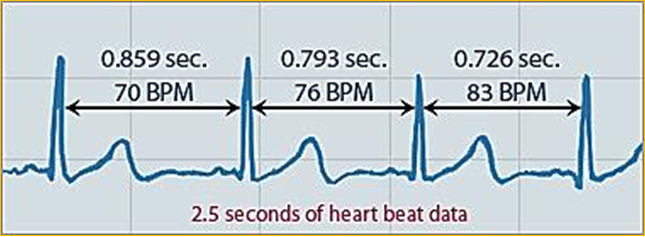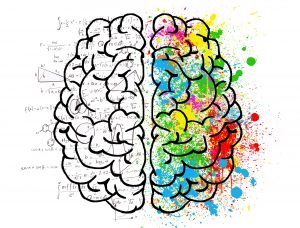What is the Heart Coherence ?
« The Heart Coherence (or Heart Rate Variability) is the expression of the physiologic increase and decrease intervals between heartbeats during cardiac cycle, under the influence of the 2 branches of the autonomic nervous system (ANS). »
The time between heartbeats is always physiologically different, by about one-tenth of a second. When a person has, at rest, a heartbeat of 80 beats per minutes (BPM), it is actually only an average heart rate.
This difference is almost imperceptible by human hand but is very interesting to therapists. Fortunately, laboratories such as the HeartMath Institute have created programs which are able to detect it.
In the picture below, you can see the instantaneous heart rate (IHR) calculated from the time between two heartbeats over the course of one minute.

Why this difference ?
The heart has a double innervation from the autonomic nervous system (ANS). This system influences heartbeats by its two branches:
- Parasympathetic innervation:
- from the tenth cranial nerve (also called pneumogastric or vagus nerve)
- decreases heart rate
- Sympathetic innervation:
- from the cardiac ganglions
- increases heart rate (but its influence is definitely less important).
At heart level, there are baroreceptors located in the blood vessels. During the breathing cycle, the intrathoracic pressure is modified. This modification reverberates on the blood vessels walls.
The baroreceptors sense it and relay the information to the nervous system:
- Breath out:
- pressure decreases
- parasympathetic stimulation
- Breath in:
- pressure increases
- parasympathetic inhibition causes sympathetic liberation
That is a really important point, because it means we are able to note the balance between these two systems and therefore see the condition of the patient’s ANS. The second important point is that we are able to have an action on the ANS by breathing.
That opens a window to the inner life.
What applications for the Heart Coherence ?
In 1996, an international working group made rules for the technical standards and interpretations of HRV results(*).
The HRV is indicative of the ANS functioning and the balance between its two divisions. It is well known that ANS is involved in coping with the stress of life. Alternatively, the different mental and emotional conditions of a person directly affect the activity of the ANS.
This interdependency is proof that the study of heart-rate variability is a powerful, objective and non-invasive tool to explore the dynamic interactions between physiological, mental, emotional and behavioral processes against an individual’s ability to cope with stress.
Some programs are able to measure the HRV with accuracy such as Emwave Desktop PC®. It gives us data that we can analyze and compare. With these indicators, it becomes easier to start a follow up support possibly improve the ANS balance to a degree that is noticeable.

(*) : Heart rate variability. Standards of measurement, physiological interpretation, and clinical use. Task Force of the European Society of Cardiology and the North American Society of Pacing and Electrophysiology. Eur Heart J. 1996;17(3):354-81.
Therapeutic interest
As we already know, we can see the ANS activity and its balance.
We are concretely informed on the patient’s capacity to deal with the stress. By comparing the different measures, we are able to note the evolution of the patient’s wellness and the effects of our treatment on them.
The purpose of this approach is to reach a state of calm and alertness not a relaxed one. Relaxation is very important to help the body and mind to recover energy faster and more efficiently. Here, we want to be ready and efficient in front of stressful situations which require us to be cognitively focused.
For the patient, it is a pedagogic approach to note when and how stress affects their physiological balance. With stress, we see an incoherence curve that means the ANS is chaotic; you are under the influence of the stress.
After an osteopathic session or with exercises, the curve can become coherent which means the ANS is balance, and you are in a calm state. This enables us to give personalized strategies to the patient and to help them recognize how they feel in a calm state.
With practice, we want to give you all tools to manage and control your emotions by reaching a calm state. Most of the time, because of being overwhelmed by our emotions, we are not able to make the correct or the best decisions. When we reconsider the situation while during a state of calm, we are able to determine what the right decision to make was.
The final purpose, for the patient, is to clearly identify the sensations felt during a calm state and how reaches them quickly and easily.
The way of health and wellness…
Sometime, a patient’s body and mind focus their energy to deal with pain. After a while, patient losses their capacity to manage stress from outside and they can become overwhelmed by any situation. In this case, the first step is to relieve the body, even just a little, by osteopathic treatments to show that a change is possible.
From this point, an osteopathy follow up combined with home exercises can be efficient tools.
The measures of a positive change of HRV are:
- decrease of heartbeats at rest,
- decrease of breathing cycle per minute,
- increase of the positive thinking,
- increase of the capacity of concentration,
- decrease of the time to reach a calm and vigilant state,
- decrease of stress influence on your professional and private life as well.

